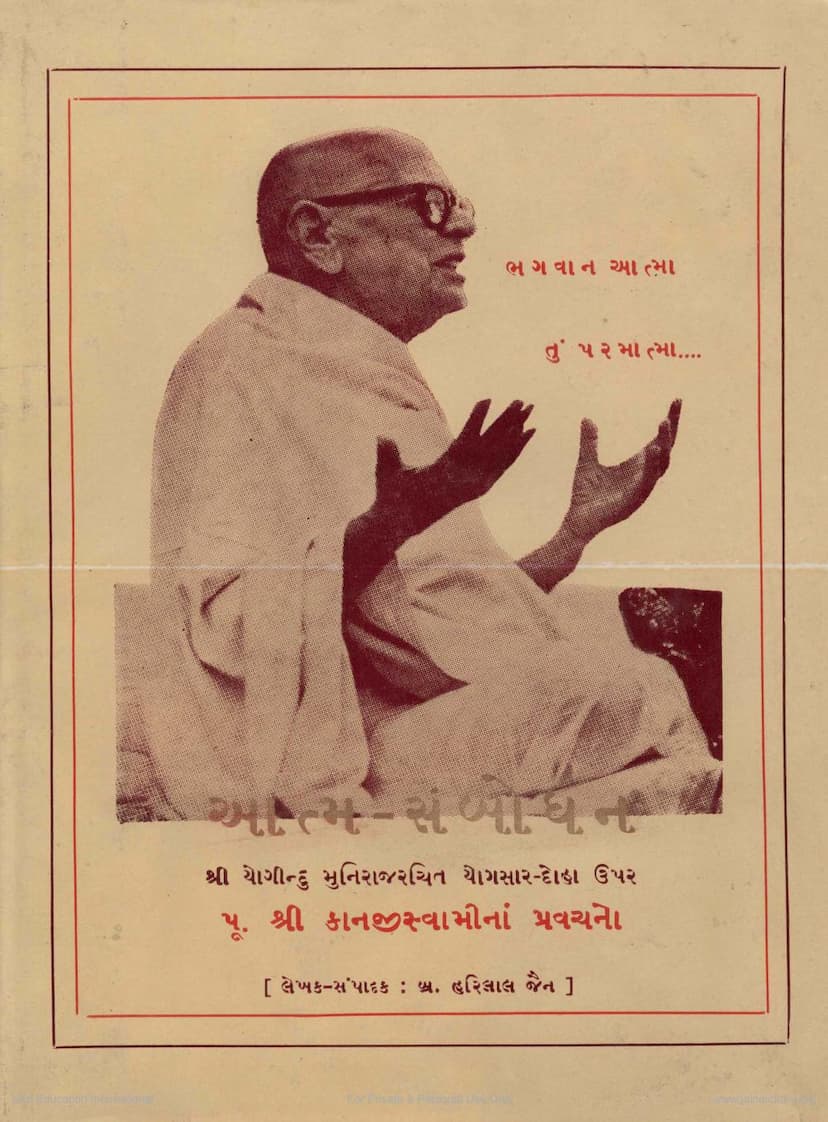Atmasambodhan
Added to library: September 1, 2025

Summary
Certainly, here's a comprehensive summary of the Jain text "Atmasambodhan" based on the provided pages:
Book Title: Atmasambodhan Author(s): Yogindudev, Hiralal Jain (Compiler/Editor) Publisher: Jain Sahitya Vikas Mandal Content: This book contains discourses by Pujya Shri Kanji Swami on the "Yogsar" (also referred to as "Pasar Doha") composed by Yogindudev Muni.
Core Message:
The central theme of "Atmasambodhan" is the realization of the true nature of the soul (Atma) as the Supreme Soul (Paramatma). It emphasizes that the soul, by its very nature, is pure, blissful, and omniscient, and that liberation (Moksha) is achieved by recognizing and abiding in this inherent divine nature. The text aims to awaken the soul from its worldly delusion and guide it towards self-realization.
Key Concepts and Teachings:
-
The Soul as Supreme: The fundamental teaching, echoed throughout the discourses, is "Bhagavan Atma nu j Paramatma" (The Soul itself is the Supreme Soul). The soul is not the body, the senses, or the external world; it is the pure, sentient, blissful, and omniscient essence.
-
Transcendence of the World: The text highlights the suffering inherent in the cycle of birth and death (samsara). It urges the reader to fear this worldly existence and seek liberation from it. This liberation is achieved by detaching from external phenomena and realizing the soul's true, untainted nature.
-
The Threefold Self (Bahiratama, Antaratma, Paramatma): The text differentiates between three states of the self:
- Bahiratama (Outer Self): One who is engrossed in external worldly concerns, identifying with the body and external objects.
- Antaratma (Inner Self): One who begins to discern the soul from the non-soul (pudgala) and focuses on internal spiritual knowledge and practice.
- Paramatma (Supreme Soul): One who has fully realized the soul's pure, inherent nature, free from all karmic defilements. The goal is to transcend from Bahiratama to Antaratma and ultimately realize Paramatma.
-
The Path to Liberation: The primary path to liberation is through self-knowledge (Atmajnana) and self-realization (Atma-dhyana). This involves:
- Detachment from the Non-Self (Para-bhava): Renouncing attachment to the body, senses, emotions, and external possessions, understanding them as separate from the soul.
- Focus on the Self (Nij-bhava): Directing attention inward to the soul's true nature, which is pure consciousness, bliss, and knowledge.
- Right Faith, Knowledge, and Conduct (Samayika, Ratnatraya): The core Jain principles of Right Faith (Samyakdarshan), Right Knowledge (Samyakjnana), and Right Conduct (Samyakcharitra) are presented as the means to achieve this self-realization.
-
The Role of the Guru: The teachings strongly emphasize the importance of a true spiritual guide (Guru) like Pujya Shri Kanji Swami. The book is presented as a testament to the compiler's (Brahmachari Hiralal Jain) gratitude for the guidance received from his Guru.
-
Rejection of External Rituals (Without Inner Understanding): While not negating all outward practices, the text prioritizes internal realization. Mere external rituals, vows, or austerities without the underlying self-knowledge are considered futile for liberation.
-
The Soul's True Nature: The soul is described as being inherently pure, blissful, and inherently possessing infinite knowledge, perception, bliss, and energy. These qualities are covered by karmic impurities but are never destroyed. The practice is to uncover and realize this inherent nature.
-
The Importance of Present Moment: The emphasis is on continuous self-reflection and practice in the present moment, as relying on future actions or conditions is unreliable.
-
Illustrative Examples and Analogies: The text uses various analogies and stories to illustrate its spiritual points, making them accessible and relatable.
Structure and Style:
- The book is a compilation of lectures delivered by Pujya Shri Kanji Swami, making the language conversational yet profound.
- The discourses are based on the "Yogsar" verses, providing a structured framework for the teachings.
- The compiler, Brahmachari Hiralal Jain, expresses deep reverence and gratitude towards his Guru, Shri Kanji Swami.
- The publisher, Jain Sahitya Vikas Mandal, is dedicated to disseminating Jain spiritual literature.
- The publication reflects a profound spiritual lineage and commitment to spiritual upliftment.
Overall Significance:
"Atmasambodhan" serves as a guide for spiritual seekers within the Jain tradition, particularly focusing on the Advaita (non-dual) perspective of the soul's inherent divinity. It aims to inspire earnest effort towards self-discovery and liberation by illuminating the true nature of the soul and the path to its realization, guided by the profound teachings of Yogindudev Muni and the elucidations of Pujya Shri Kanji Swami.